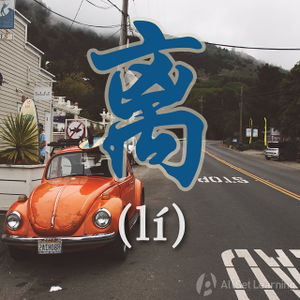Difference between revisions of "Comparing "li" and "cong""
| Line 75: | Line 75: | ||
<div class="liju"> | <div class="liju"> | ||
| − | *第一次 世界 大战 <em>离</em>第二次 世界 大战 不到 50年。<span class="pinyin"> Dì yī cì shìjiè dàzhàn <em>lí</em> dì èr cì shìjiè | + | *第一次 世界 大战 <em>离</em>第二次 世界 大战 不到 50年。<span class="pinyin"> Dì yī cì shìjiè dàzhàn <em>lí</em> dì èr cì shìjiè dàzhàn bù dào 50 nián. </span><span class="trans"> World War I and World War II are less than 50 years apart. </span> |
</div> | </div> | ||
Revision as of 07:33, 30 May 2016
| This article is a stub. Editors can help the Chinese Grammar Wiki by expanding it. |
-
Level
-
Similar to
-
Used for
-
Keywords
Both 离 (lí) and 从 (cóng) can be translated into English as “from”. In Chinese however, their meanings are different. 从 is used in cases where the subject's position relative to a fixed location changes. 离 expresses a “static” distance, or a distance that is unchanging. Both can be used in defining distance or time, however从 has more meanings than 离.
Contents
从
From (time)
Structure
从 + Time + 开始/起/以来…
Examples
- 从 明天 开始,我 不 抽烟 了。 Starting tomorrow, I will not smoke.
- 从 有 了 女朋友 以后,他 不 泡妞 了。 After he gets a girlfriend, he won’t flirt with girls.
From (place)
Structure
从 + Place + 到/向…
Examples
- 他 从 地上 拿 起来了 一百 块。 He picked up one hundred RMB from the ground.
From (amount)
Examples
- 从 学生 到 老师 都 放假 了。 Everyone, from the students to the teachers, are on holiday.
From (change)
Examples
- 他 从 最 差 的 学生 变成 了 最 认真 的 学生。 He went from being the worst student to the best student.
离
From (distance)
Structure
Examples
- 我 的 学校 离 你家 很远。 My school is far from your house.
From (time)
Structure
Examples
- 第一次 世界 大战 离第二次 世界 大战 不到 50年。 World War I and World War II are less than 50 years apart.
Sources and further reading
Books
现代汉语虚词俐释 (pp. 335)
实用对外汉语教学语法 (pp. 263)



